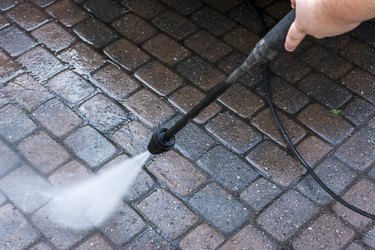
You might be able to find an older power washer with the Honda name, but most pressure washers with a Honda engine bear the label of another manufacturer, such as Ryobi, Homelite or Craftsman. Although each manufacturer adds its own features to the spray equipment, the operation of the Honda engine is uniform from model to model, and troubleshooting it is similar to troubleshooting a lawnmower engine. Most spray problems can be rectified by adjusting the water supply or consulting your owner's manual.
Engine Problems
Video of the Day
Performance problems in any small engine come down to lack of maintenance, lack of fuel, poor quality fuel or incorrect operating procedures.
Video of the Day
Engine Won't Start
Make sure you're using the correct starting procedure. For example, the procedure for starting a Homelite UT80432, which uses a Honda GVC190 engine, is to turn the fuel valve on and pull out the choke before pulling the starting rope. Once the engine is running, you must push the choke back in or the engine will sputter and die. If you can't get the engine to start:
- It may be flooded. Try cranking it with the choke in. If you smell gas, let the engine sit idle for 10 minutes before trying again.
- The air filter may be dirty. Open the air filter compartment, and clean the filter with compressed air or soap and water, depending on the recommendation in the owner's manual.
- The spark plug may not be firing. Unhook the boot; remove the plug and inspect the terminals. If they are clogged with black deposits, clean them with sandpaper or a file. If the they are corroded, replace the plug.
- The fuel may be bad. If the power washer has been in storage with gas in the tank and you forgot to add stabilizer, drain the old fuel and replace it with fresh fuel. Old fuel can collect moisture that foils the carburetor.
- The carburetor or fuel lines may need cleaning. You may need to disassemble the carburetor for a thorough cleaning, but first try removing the air filter and spraying starting fluid in through the air intake port. If the engine turns over, it may burn off some of the sludge that's causing the problems.
Engine Stalls
If the engine doesn't run to speed or it stalls when you try to spray, the problem is often blocked air passages. Clean or replace the air filters. It's also possible that the carburetor needs adjustment -- take the unit in for servicing if you suspect this.
Operation of the Sprayer
It's important to connect the unit to a water source and turn on the water before starting the engine. Before you start the engine, press the trigger on the wand and make sure you see a steady stream of water. If not, check the water spigot and look for kinks in the hose.
Low Nozzle Pressure
If you don't get the pressure you expect after starting the engine and pulling the trigger:
- The nozzle may be blocked. Shut down the engine; remove the nozzle and clean it by back-flushing it with water.
- If you have an adjustable nozzle with multiple settings, make sure you've selected the proper setting. A setting for mixing soap for cleaning has a wide aperture that won't provide much pressure.
- It's also possible that a filter in the hose or at the spigot needs to be cleaned.
Falling Pressure
If the pressure is adequate when you pull the trigger but gradually falls off:
- It could mean that the water source isn't supplying enough water. Disconnect the hose and measure the gallons per minute from the spigot, using a bucket. Compare this number to the requirements for the power washer you're using.
- There may be a kink in the garden hose supplying the power washer.
- One of the supply fitting or hoses may be leaking.
Soap Injector
If the soap injector isn't working:
- Make sure you've set the nozzle to the correct setting. The unit won't draw soap if the nozzle is in a high-pressure position.
- Turn on the soap injector valve.
- Disassemble the injector and clean it. Something may be blocking it.